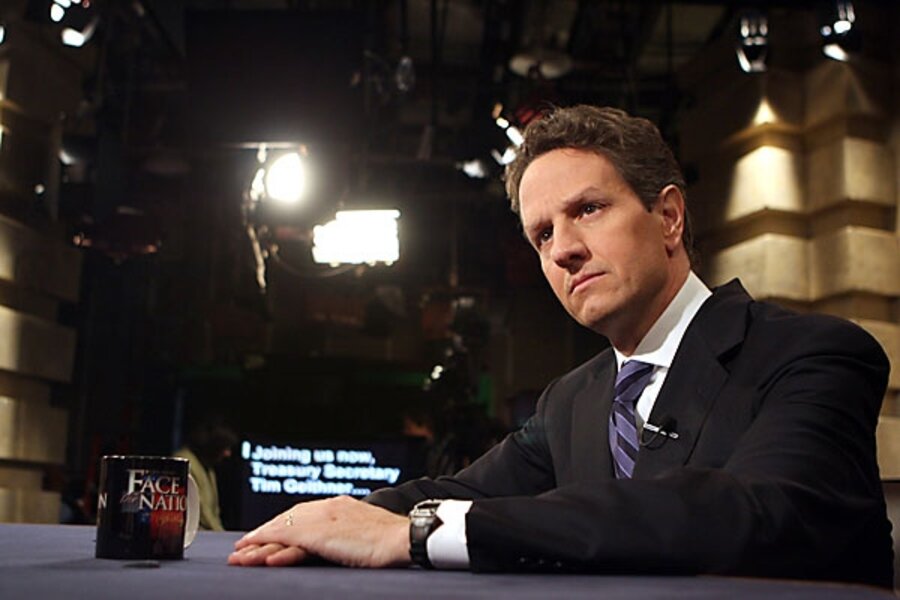Might more stimulus be needed? Not yet, says Geithner.
Loading...
| New York
Despite some calls for a second fiscal stimulus package, the Obama administration has no immediate plans to ask Congress for another spending bill to help the American economy.
Instead, the administration says it will monitor the economy to see how much help comes from the $787 billion stimulus package enacted Feb. 17.
“We can’t make that judgment [to ask for more money] at this time,” said US Treasury Secretary Timothy Geithner, in answer to a question Sunday on CBS’s “Face the Nation.” “First we have to do with what we have.”
Mr. Geithner, expressing some optimism, cited progress in areas where the administration and the Federal Reserve have intervened so far. He specifically pointed to mortgage rates, which “are at their lowest point.”
On Friday, the rate on a conventional 30-year, fixed mortgage fell to 4.78 percent, down from 4.85 percent the previous week, said Freddie Mac, the government-run corporation that buys and guarantees mortgage loans. This is the lowest rate since Freddie Mac started keeping track of rates in 1971. A year ago, the rate for such a mortgage was 5.88 percent.
Geithner cited “encouraging signs” that the economy is starting to bottom out. But he warned that the economy, now in its fifth quarter of recession, would make progress in “fits and starts.”
This month, for example, 95 percent of working Americans will see a slight increase in their take-home pay as part of a reduction in the amount of money withheld for taxes, a provision of the fiscal stimulus package. Moreover, 55 million Americans living on Supplemental Security Income (SSI) or Social Security may qualify for a one-time $250 check to be mailed in late May.
“It should help with basic spending,” says Dennis Jacobe, Washington-based chief economist at Gallup Inc.
At the same time, however, the unemployment rate is continuing to climb, hitting 8.5 percent in March, the Department of Labor reported Friday. That's the highest level since November 1983.
Geithner allowed that the unemployment rate may continue to rise. “Growth turns positive before unemployment peaks,” he said Sunday. “It’s a crude reality of recoveries.”
In the first three months of 2009, the nation lost 2 million jobs as businesses went into survival mode.
Because job cuts were so steep early in the year, there is hope among some economists that they will begin to slow in the second quarter.
“I don’t think we’ll be getting 2 million more job losses in the next three months,” says Joel Naroff of Naroff Economic Advisors in Holland, Pa.
In fact, the number of planned job cuts fell 19 percent to 150,411 in March, said Challenger, Gray & Christmas, a Chicago outplacement firm, on Wednesday. This was the second consecutive decline and the lowest number since last October. It usually takes several months after a company announces layoffs for the workforce cuts to actually occur.
Despite the rising jobless rate, some economists see some encouraging signs. For one, it appears fewer pink slips were handed out in March. On a nonseasonally adjusted basis, the loss of jobs was just 58,000. But businesses normally begin hiring workers in March in anticipation of stronger orders for the summer. This did not happen, so the Labor Department found that the nation, on a seasonally adjusted basis, had shed 663,000 jobs.
“The job losses are like a ski slope: They were steep at first, and now we are leveling off,” says David Wyss, chief economist at Standard & Poors in New York. “When we get down the bottom of the mountain, there may be a chair lift in the distant future.”
Some kind of chair lift for General Motors appears to be in the offing, although it’s not clear if the automaker will have to go through bankruptcy first.
“GM will be a part of this country’s future,” said Geithner, adding that the company will need substantial restructuring. The Obama administration’s goal, he said, is for GM to emerge from that restructuring so it can survive without government help on an ongoing basis.
Only a week ago, the Obama team forced out GM CEO Rick Wagoner. CBS’s Bob Shieffer wanted to know if the same would befall executives of banks such as Citigroup and Bank of America, which have received billions in bailout money from the government. Geithner answered obliquely.
He pointed out that when the government needed to act, as in the case of Freddie Mac and insurance giant AIG, it replaced top management. “We will do it in the future if necessary,” he said.
The key factor, he seemed to indicate, would be whether the large financial organizations are loaning money to help the economy. “To make sure they are supporting the recovery, we would make changes in the management if necessary,” he said.





